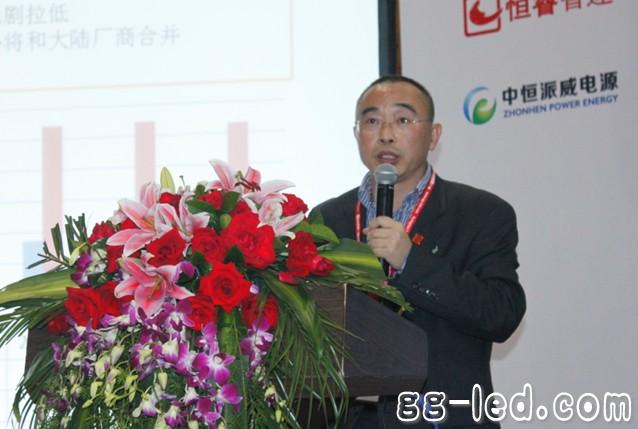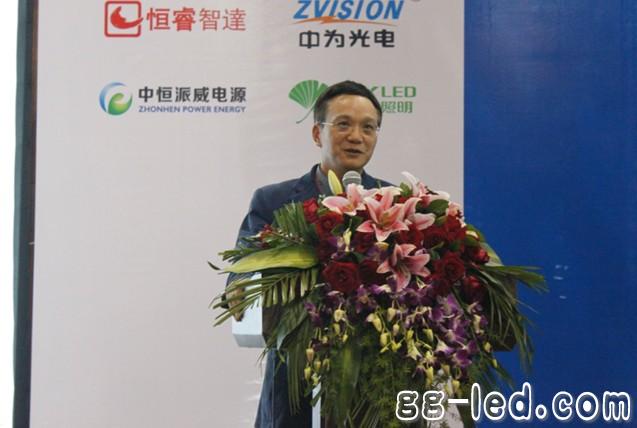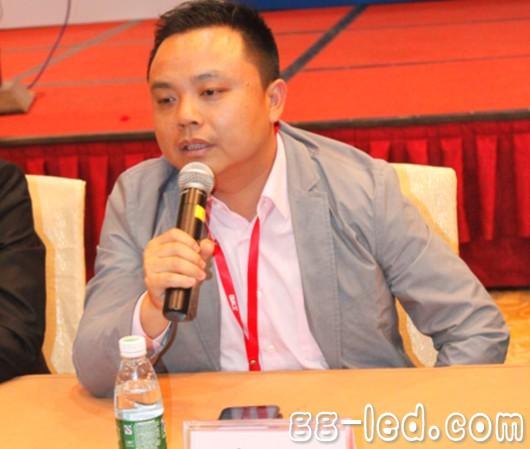[High-tech LED reporter Zhao Hui] In 2013, due to the rapid development of the lighting industry, the production capacity of the upper, middle and lower reaches has been fully utilized, and the overcapacity has slowed down. Whether it is materials, equipment, or equipment, the entire industry is thriving. The capacity utilization rate of the upstream epitaxial chip sector has also risen from less than 30% in 2012 to nearly 60% today.
"MOCVD is the world's number one, and the future output value is the world's first. The quality and cost performance of domestic chips are rapidly increasing, which will drastically lower the price of imported chips." Gao Gong LED CEO Dr. Zhang Xiaofei held the 2013 Gaogong LED on November 25th. The conference said that the number of MOCVD will continue to increase in the future. It used to be a structural surplus, and in terms of quantity, it was a bit surplus in some sense. However, due to the reduction in our output, there is no excess capacity.
In the future, China's local chip manufacturers will eventually survive no more than 12, Dr. Zhang Xiaofei predicted that domestic MOCVD manufacturers will not survive more than two. Most upstream companies will gradually die, with a survival rate of around 30%.
Domestic chip development
In 2013, China's LED industry began the first step towards success. This year has changed a lot. No matter upstream, midstream or downstream, it has gradually begun to have its own position in the market.
"In 2013, the chip brought high-speed development opportunities to the entire LED, because we are constantly engaged in price competition." Wang Lianghai, vice president of Tongfang, said that after several years of development, the domestic and international chip industry has reduced the price of the entire LED to 20 %, 30%, this data is only available to Chinese companies to complete such a great task.
Wang Lianghai said that before 2012, especially in 2011 and 2012, Chinese chip companies mainly relied on imitation, including digging a lot of people from Taiwan's epitaxial chip companies, mainly in imitation. In 2013 and 2014, the domestic chip industry will adopt a follow-up policy, aiming at overseas product development and continuing to fight price wars. In 2015, there will be some products, China's chips will lead, and there will continue to be innovations.
Li Guoping, chairman of the G20-LED Summit, said that in the field of indoor lighting and commercial lighting, the replacement speed of domestic chips is very fast.
"In the past two years, many big companies have not specified which chip to use. As long as the chip quality is good, it is acceptable. I remember that 80% of the chips were purchased from Taiwan or foreign brands three or four years ago. 90% of the company began to purchase domestic chips." Li Guoping told the "High-tech LED" reporter, now Hongli's customers now also accept domestic chips, and even take the initiative to use a domestic brand of chips.
Price war is not sustainable
Due to the structural excess of the production capacity of the epitaxial chip in the past two years, the price war has stimulated, and the production of chip companies has also fallen into a predicament. With the advancement of technology and the increasing demand for downstream lighting, the domestic chip industry is gradually coming out of the trough.
“For the upstream companies, the biggest problem is the price war. Because of the price war, this industry has a booming boost. But the price will also bring the pressure of business pressure and re-development.†Wang Lianghai believes that the price war is at least There are two years, but the price increase of the chip is basically impossible, and it is still necessary to take the market demand as the leading factor, so it is impossible to raise the price.
Wang Lianghai said that from the perspective of the industrial stage, the first stage is a price war, starting from 2012 and basically stable this year. Chip companies will not raise prices, but there will not be too much room for price cuts. It is about to enter an era of product performance competition, the same price, who's product performance is better.
"There is a technical war with it. Now LED chips are far from the theoretical luminous effect. Many companies in China, including those in other countries, are doing some deeper research and development work." Wang Lianghai said I hope that it can be used for half a year to one year, or two years, to increase the luminous efficiency of current LED chips by 30%-50%, and can reach 200 or more.
Technical warfare is a time to really fight for enterprise strength in this respect, because R&D requires a lot of investment. At this stage, many companies, if they can't keep up, can only wait for the downstream, maybe a FED, or other products.
Zhou Lujun, director of marketing for Philips Lumileds Asia, believes that the goals are consistent in the upstream, midstream and downstream, in order to solve the satisfaction of LED end users. For the upstream, to make customers satisfied, but also to make customers' customers satisfied, this is the highest purpose.
"Now the level of domestic chip technology has been greatly improved, in terms of cost performance, especially cost-effective, the market share in the domestic market will become larger and larger." Dr. Zhang Xiaofei said that this is a driving force for the upstream of the entire market. The most basic stability energy has been able to meet the outdoor indoor lighting, which makes the localized procurement is gradually expanding.
"MOCVD is the world's number one, and the future output value is the world's first. The quality and cost performance of domestic chips are rapidly increasing, which will drastically lower the price of imported chips." Gao Gong LED CEO Dr. Zhang Xiaofei held the 2013 Gaogong LED on November 25th. The conference said that the number of MOCVD will continue to increase in the future. It used to be a structural surplus, and in terms of quantity, it was a bit surplus in some sense. However, due to the reduction in our output, there is no excess capacity.

In the future, China's local chip manufacturers will eventually survive no more than 12, Dr. Zhang Xiaofei predicted that domestic MOCVD manufacturers will not survive more than two. Most upstream companies will gradually die, with a survival rate of around 30%.
Domestic chip development
In 2013, China's LED industry began the first step towards success. This year has changed a lot. No matter upstream, midstream or downstream, it has gradually begun to have its own position in the market.
"In 2013, the chip brought high-speed development opportunities to the entire LED, because we are constantly engaged in price competition." Wang Lianghai, vice president of Tongfang, said that after several years of development, the domestic and international chip industry has reduced the price of the entire LED to 20 %, 30%, this data is only available to Chinese companies to complete such a great task.

Wang Lianghai said that before 2012, especially in 2011 and 2012, Chinese chip companies mainly relied on imitation, including digging a lot of people from Taiwan's epitaxial chip companies, mainly in imitation. In 2013 and 2014, the domestic chip industry will adopt a follow-up policy, aiming at overseas product development and continuing to fight price wars. In 2015, there will be some products, China's chips will lead, and there will continue to be innovations.
Li Guoping, chairman of the G20-LED Summit, said that in the field of indoor lighting and commercial lighting, the replacement speed of domestic chips is very fast.

"In the past two years, many big companies have not specified which chip to use. As long as the chip quality is good, it is acceptable. I remember that 80% of the chips were purchased from Taiwan or foreign brands three or four years ago. 90% of the company began to purchase domestic chips." Li Guoping told the "High-tech LED" reporter, now Hongli's customers now also accept domestic chips, and even take the initiative to use a domestic brand of chips.
Price war is not sustainable
Due to the structural excess of the production capacity of the epitaxial chip in the past two years, the price war has stimulated, and the production of chip companies has also fallen into a predicament. With the advancement of technology and the increasing demand for downstream lighting, the domestic chip industry is gradually coming out of the trough.
“For the upstream companies, the biggest problem is the price war. Because of the price war, this industry has a booming boost. But the price will also bring the pressure of business pressure and re-development.†Wang Lianghai believes that the price war is at least There are two years, but the price increase of the chip is basically impossible, and it is still necessary to take the market demand as the leading factor, so it is impossible to raise the price.
Wang Lianghai said that from the perspective of the industrial stage, the first stage is a price war, starting from 2012 and basically stable this year. Chip companies will not raise prices, but there will not be too much room for price cuts. It is about to enter an era of product performance competition, the same price, who's product performance is better.
"There is a technical war with it. Now LED chips are far from the theoretical luminous effect. Many companies in China, including those in other countries, are doing some deeper research and development work." Wang Lianghai said I hope that it can be used for half a year to one year, or two years, to increase the luminous efficiency of current LED chips by 30%-50%, and can reach 200 or more.
Technical warfare is a time to really fight for enterprise strength in this respect, because R&D requires a lot of investment. At this stage, many companies, if they can't keep up, can only wait for the downstream, maybe a FED, or other products.
Zhou Lujun, director of marketing for Philips Lumileds Asia, believes that the goals are consistent in the upstream, midstream and downstream, in order to solve the satisfaction of LED end users. For the upstream, to make customers satisfied, but also to make customers' customers satisfied, this is the highest purpose.
"Now the level of domestic chip technology has been greatly improved, in terms of cost performance, especially cost-effective, the market share in the domestic market will become larger and larger." Dr. Zhang Xiaofei said that this is a driving force for the upstream of the entire market. The most basic stability energy has been able to meet the outdoor indoor lighting, which makes the localized procurement is gradually expanding.

Gaming ATX Power,High Efficiency Game ATX Power,Game Mute Version Computer Power Manufacturers and Suppliers in China
Boluo Xurong Electronics Co., Ltd. , https://www.greenleaf-pc.com